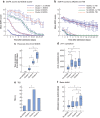Multiple organ dysfunction after trauma
- PMID: 31691956
- PMCID: PMC7078999
- DOI: 10.1002/bjs.11361
Multiple organ dysfunction after trauma
Abstract
Background: The nature of multiple organ dysfunction syndrome (MODS) after traumatic injury is evolving as resuscitation practices advance and more patients survive their injuries to reach critical care. The aim of this study was to characterize contemporary MODS subtypes in trauma critical care at a population level.
Methods: Adult patients admitted to major trauma centre critical care units were enrolled in this 4-week point-prevalence study. MODS was defined by a daily total Sequential Organ Failure Assessment (SOFA) score of more than 5. Hierarchical clustering of SOFA scores over time was used to identify MODS subtypes.
Results: Some 440 patients were enrolled, of whom 245 (55·7 per cent) developed MODS. MODS carried a high mortality rate (22·0 per cent versus 0·5 per cent in those without MODS; P < 0·001) and 24·0 per cent of deaths occurred within the first 48 h after injury. Three patterns of MODS were identified, all present on admission. Cluster 1 MODS resolved early with a median time to recovery of 4 days and a mortality rate of 14·4 per cent. Cluster 2 had a delayed recovery (median 13 days) and a mortality rate of 35 per cent. Cluster 3 had a prolonged recovery (median 25 days) and high associated mortality rate of 46 per cent. Multivariable analysis revealed distinct clinical associations for each form of MODS; 24-hour crystalloid administration was associated strongly with cluster 1 (P = 0·009), traumatic brain injury with cluster 2 (P = 0·002) and admission shock severity with cluster 3 (P = 0·003).
Conclusion: Contemporary MODS has at least three distinct types based on patterns of severity and recovery. Further characterization of MODS subtypes and their underlying pathophysiology may lead to future opportunities for early stratification and targeted interventions.
Antecedentes: La naturaleza del síndrome de disfunción orgánica múltiple (Multiple Organ Dysfunction Syndrome, MODS) resultante de un traumatismo está evolucionando a medida que avanzan las prácticas de reanimación y más pacientes sobrevive a las lesiones y pueden recibir cuidados críticos. El objetivo de este estudio fue caracterizar los subtipos actuales MODS en atención crítica de trauma a nivel poblacional. MÉTODOS: Los pacientes adultos ingresados en unidades de cuidados intensivos de trauma se incluyeron en este estudio de prevalencia puntual de 4 semanas. MODS se definió como una puntuación total diaria de la escala de Evaluación de Fallo Orgánico Secuencial (Sequential Organ Failure Assessment, SOFA) > 5. Se utilizó el agrupamiento jerárquico de las puntuaciones SOFA a lo largo del tiempo para determinar los subtipos MODS.
Resultados: Se incluyeron 440 pacientes, de los cuales 245 (56%) presentaron MODS. MODS conllevó una alta mortalidad (22% versus 1%, P < 0,001) y 24% de las muertes fueron precoces, durante las primeras 48 horas tras el traumatismo. Se identificaron tres patrones de MODS, estando todos presentes al ingreso. En el tipo 1, MODS se resolvió de forma temprana, con una mediana de tiempo de recuperación de 4 días y una mortalidad del 14%. El tipo 2 presentaba un tiempo de recuperación retardado (mediana 13 días) y una mortalidad del 35%. El tipo 3 presentaba un tiempo de recuperación prolongado (mediana 25 días) y una mortalidad asociada alta del 46%. El análisis multivariable reveló asociaciones clínicas diferentes para cada tipo de MODS, con la administración de cristaloides durante 24 horas fuertemente asociada al tipo 1 (P < 0,001); el traumatismo craneal al tipo 2 (P < 0,01); y la gravedad del shock al ingreso al tipo 3 (P < 0,01). CONCLUSIÓN: Los MODS actuales presentan al menos tres tipos distintos basados en patrones de gravedad y recuperación. La caracterización de los subtipos de MODS y su fisiopatología subyacente puede contribuir a futuras oportunidades de estratificación temprana e intervenciones dirigidas.
© 2019 The Authors. BJS published by John Wiley & Sons Ltd on behalf of BJS Society Ltd.
Figures



References
-
- Fröhlich M, Lefering R, Probst C, Paffrath T, Schneider MM, Maegele M et al; Committee on Emergency Medicine, Intensive Care and Trauma Management of the German Trauma Society Sektion NIS . Epidemiology and risk factors of multiple‐organ failure after multiple trauma: an analysis of 31 154 patients from the TraumaRegister DGU. J Trauma Acute Care Surg 2014; 76: 921–928. - PubMed
-
- Cannon JW, Khan MA, Raja AS, Cohen MJ, Como JJ, Cotton BA et al Damage control resuscitation in patients with severe traumatic hemorrhage: a practice management guideline from the Eastern Association for the Surgery of Trauma. J Trauma Acute Care Surg 2017; 82: 605–617. - PubMed
MeSH terms
Substances
LinkOut - more resources
Full Text Sources
Medical

